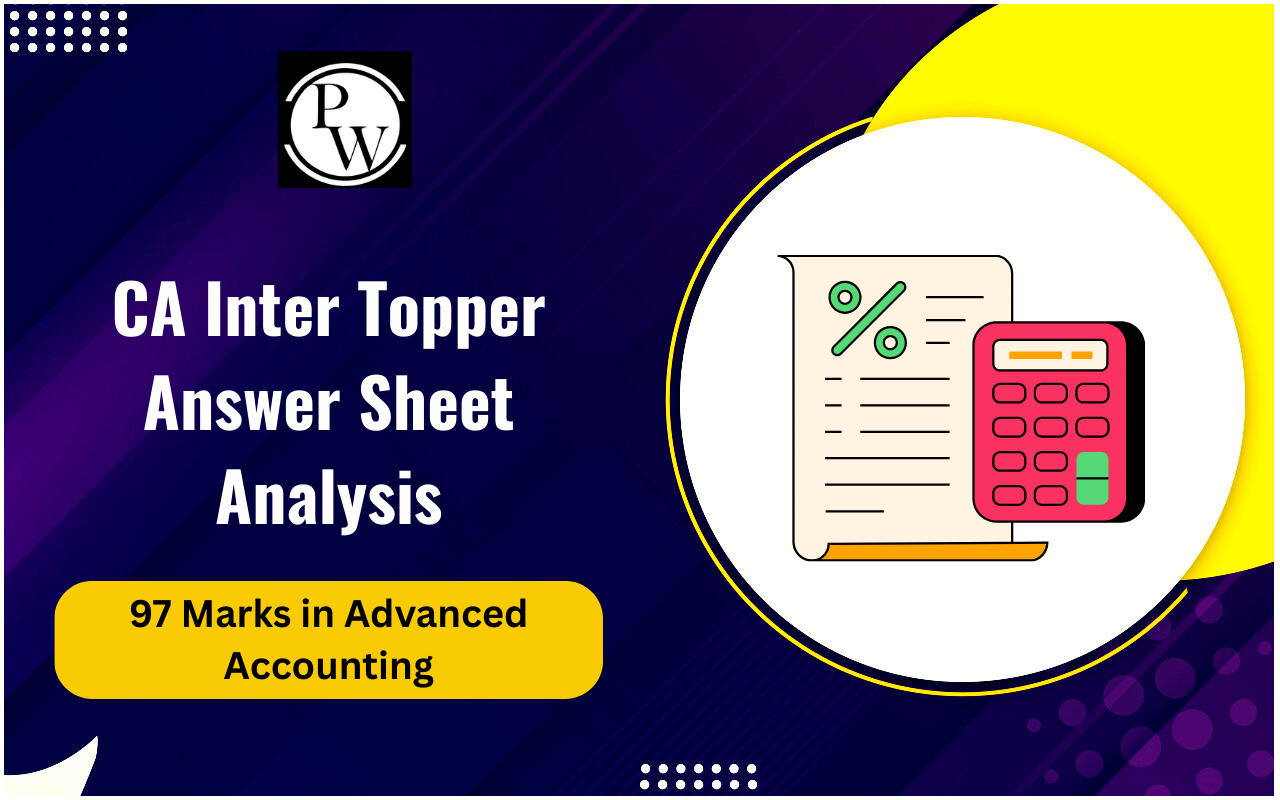
CA Intermediate Chapter-Wise Weightage: The Institute of Chartered Accountants of India (ICAI) has recently designated the Board of Studies (BoS) to assign specific marks to different sections of the CA Inter syllabus. This platform is designed to help students plan their study routines for the upcoming ICAI exams.
To simplify, each subject is now divided into several topics, further categorized into parts with varying importance. The question paper will reflect the assigned weight to each section. If you're feeling overwhelmed about where to start your CA Intermediate preparation , it's because of the time commitment required for each section.Understanding the CA Intermediate chapter-wise weightage for every subject can make this clearer. CA Intermediate is the second level in the CA pathway, a prerequisite for advancing to the third level. As each level poses a greater challenge, it's crucial to buckle down and concentrate on learning. For those enrolled in the CA Intermediate course, reaching out to PW CA Intermediate Course and initiating studies early is recommended.
CA Intermediate Chapter-Wise Weightage 2025
CA Intermediate exams are a crucial step in the journey to becoming a Chartered Accountant, requiring a strategic approach to preparation. Understanding the CA Intermediate chapter-wise weightage is essential for candidates aiming to optimize their study plans and focus on key areas. The distribution of marks across subjects provides valuable insights into the relative importance of each chapter, guiding students to allocate their time and efforts efficiently. This detailed insight empowers students to prioritize topics, emphasizing a balanced and targeted preparation strategy that aligns with the examination pattern. Ultimately, being cognizant of chapter-wise weightage aids aspiring Chartered Accountants in achieving success in the CA Intermediate examinations.CA Inter Subject Wise Weightage
Navigating the CA Intermediate exams requires a strategic understanding of subject-wise weightage. In this crucial phase of Chartered Accountancy, candidates must prioritize their study efforts based on the distribution of marks in CA Intermediate Syllabus . Check CA Intermediate Subject-wise weightage below:Paper 1: Advanced Accounting (100 Marks)
Check CA Intermediate Chapter-wise Weightage for Advanced Accounting in the table below:| CA Intermediate Chapter-wise Weightage for Advanced Accounting | ||
| Contents | Section | Weightage |
| 1. Process of formulation of Accounting Standards including Indian Accounting Standards (IFRS converged standards) and IFRSs; Convergence vs Adoption; Objective and Concepts of carve outs. | I | 55%-65% |
| 2. Framework for Preparation and Presentation of Financial Statements (as per Accounting Standards). | ||
| 3. (i) Applicability of Accounting Standards to various entities | ||
| (ii) Application of Accounting Standards: | ||
| - AS 1: Disclosure of Accounting Policies | ||
| - AS 2: Valuation of Inventories | ||
| - AS 3: Cash Flow Statements | ||
| - AS 4: Contingencies and Events Occurring After the Balance Sheet Date | ||
| - AS 5: Net Profit or Loss for the Period, Prior Period Items and Changes in Accounting Policies | ||
| - AS 7: Construction Contracts | ||
| - AS 9: Revenue Recognition | ||
| - AS 10: Property, Plant and Equipment | ||
| - AS 11: The Effects of Changes in Foreign Exchange Rates | ||
| - AS 12: Accounting for Government Grants | ||
| - AS 13: Accounting for Investments | ||
| - AS 14: Accounting for Amalgamations (excluding inter-company holdings) | ||
| - AS 15: Employee Benefits | ||
| - AS 16: Borrowing Costs | ||
| - AS 17: Segment Reporting | ||
| - AS 18: Related Party Disclosures | ||
| - AS 19: Leases | ||
| - AS 20: Earnings Per Share | ||
| - AS 21: Consolidated Financial Statements of single subsidiaries (excluding specific problems) | ||
| - AS 22: Accounting for Taxes on Income | ||
| - AS 23: Accounting for Investment in Associates in Consolidated Financial Statements | ||
| - AS 24: Discontinuing Operations | ||
| - AS 25: Interim Financial Reporting | ||
| - AS 26: Intangible Assets | ||
| - AS 27: Financial Reporting of Interests in Joint Ventures | ||
| - AS 28: Impairment of Assets | ||
| - AS 29: Provisions, Contingent Liabilities and Contingent Assets | ||
| 4. Company Accounts | II | 30%-35% |
| (i) Schedule III to the Companies Act, 2013 (Division I) | ||
| (ii) Preparation of financial statements – Statement of Profit and Loss, Balance Sheet and Cash Flow Statement | ||
| (iii) Buy back of securities | ||
| (iv) Accounting for reconstruction of companies | ||
| 5. Accounting for Branches including foreign branches. | III | 5%-10% |
Paper 2: Corporate and Other Laws (100 Marks)
The CA Intermediate Chapter-Wise Weightage for Corporate and Other Laws in the table below:| CA Intermediate Chapter-wise Weightage for Corporate and Other Laws | |||
| Part | Contents | Sections | Weightage |
| Part I – Company Law and LLP Law (70 Marks) | The Companies Act, 2013 including important rules and drafting of notices, resolutions –
|
I |
20%-30% |
|
II |
20%-30% | |
|
III |
30%-35% | |
| The Limited Liability Partnership Act, 2008 including important Rules |
IV |
15%-20% | |
| Part II – Other Laws (30 Marks) | The General Clauses Act, 1897: Important Definitions, Extent and Applicability, General Rules of Construction, Powers and Functionaries, Provisions as to Orders, Rules, etc. made under Enactments and Miscellaneous Provisions |
I |
35%-40% |
| Interpretation of statutes : Rules of Interpretation of Statutes, Aids to Interpretation, Rules of Interpretation/Construction of Deeds and Documents |
II |
25%-30% | |
| The Foreign Exchange Management Act, 1999: Significant definitions and concepts of Current and Capital Account Transactions |
III |
30%-40% | |
Paper 3: Taxation (100 Marks)
Check the table below for CA Intermediate Chapter-Wise Weightage for Paper 3 Taxation, divided into two sections:| CA Intermediate Chapter-wise Weightage for Taxation | |||
| Part | Contents | Section | Weightage |
|
Section A: Income-Tax Laws (50 Marks)
|
1. Basic Concepts (i) Income-tax law: An introduction (ii) Significant concepts in income-tax law, including person, assessee, previous year, assessment year, income, agricultural income (iii) Basis of Charge (iv) Procedure for computation of total income and tax payable in case of individuals |
I |
10%-20% |
| 2. Residential status and scope of total income (i) Residential status (ii) Scope of total income | |||
| 3. Heads of income and the provisions governing computation of income under different heads (i) Salaries (ii) Income from house property (iii) Profits and gains of business or profession (iv) Capital gains (v) Income from other sources |
II |
25%-30% | |
| 4. Provisions relating to clubbing of income, set-off or carry forward and set-off of losses, deductions from gross total income |
III |
15%-20% | |
| 5. Advance Tax, Tax deduction at source and tax collection at source |
IV |
15%-20% | |
| 6. Provisions for filing return of income and self-assessment | |||
| 7. Computation of total income and income-tax payable by an individual under the alternative tax regimes under the Income-tax Act, 1961 to optimise tax liability. |
V |
20%-25% | |
| Section B: Goods and Services Tax (GST) (50 Marks) | 1. GST Laws: An introduction including Constitutional aspects |
I |
0-5% |
2. Levy and collection of CGST and IGST
|
II
|
50%-80% | |
3. Basic concepts of:
|
|||
| 4. Computation of GST liability | |||
| 5. Registration |
III
|
20%-45% | |
| 6. Tax invoice; Credit and Debit Notes; Electronic way bill | |||
| 7. Accounts and Records | |||
| 8. Payment of tax | |||
| 9. Returns | |||
Paper 4: Cost and Management Accounting (100 Marks)
The table below provides CA Intermediate Chapter-Wise Weightage for Cost and Management Accounting:| CA Intermediate Chapter-wise Weightage for Cost and Management Accounting | ||
| Contents | Section | Weightage |
| Overview of Cost and Management Accounting | I | 10%-15% |
| Ascertainment of Cost and Cost Accounting System | II | 35%-40% |
| Methods of Costing | III | 20%-25% |
| Cost Control and Analysis | IV | 25%-30% |
Paper 5: Auditing and Ethics (100 Marks)
Check CA Intermediate Chapter-wise Weightage for Auditing and Ethics in the table below:| CA Intermediate Chapter-wise Weightage for Auditing and Ethics | ||
| Contents | Section | Weightage |
| Nature, Objective and Scope of Audit | I | 4%-6% |
| Audit Strategy, Audit Planning and Audit Program | II | 8%-12% |
| Risk Assessment and Internal Control | III | 8%-12% |
| Audit Evidence | IV | 12%-18% |
| Audit Documentation | ||
| Audit of Items of Financial Statements | V | 12%-20% |
| Completion and Review | VI | 8%-12% |
| Audit Report | VII | 8%-12% |
| Special Features of Audit of Different Type of Entities | VIII | 12%-18% |
| Audit of Banks | ||
| Ethics and Terms of Audit Engagements | IX | 8%-10% |
Paper 6: Financial Management and Strategic Management (100 Marks)
Check CA Intermediate Chapter-wise Weightage for Financial Management and Strategic Management in the table below:| CA Intermediate Chapter-wise Weightage for Financial Management and Strategic Management | |||
| Part | Contents | Section | Weightage |
| Part 6A: Financial Management | Financial Management and Financial Analysis | I | 10%-15% |
| Financing Decisions and Cost of Capital | II | 45%-50% | |
| Capital Investment and Dividend Decisions | III | 20%-25% | |
| Management of Working Capital | IV | 15%-20% | |
| Part 6B: Strategic Management | Introduction to Strategic Management | I | 15%-25% |
| Strategic Analysis: External Environment | II | 15%-25% | |
| Strategic Analysis: Internal Environment | III | 15%-25% | |
| Strategic Choices | IV | 15%-25% | |
| Strategy Implementation and Evaluation | V | 15%-25% | |
CA Intermediate Syllabus
The CA Intermediate Syllabus has been updated to align with ICAI's revised education scheme, introducing significant changes and enhancements. Previously known as CA IPCC, the program is now called CA Intermediate. In the earlier system, there were 7 papers with a total of 700 marks. Under the updated structure, there are 8 papers, raising the total marks to 800. After reviewing the syllabus, it's time to start your preparation. Begin by creating a study plan that aligns with the CA Test Series Schedule. Following a well-structured timetable with focus and dedication will boost your chances of success at this level.CA Intermediate Exam Pattern
ICAI has introduced a new exam pattern for the CA Intermediate level. These exams are conducted offline, similar to other major exams. Aspiring candidates should review the exam pattern for their specific year to understand the differences between the old and new schemes, along with the key aspects of the question paper. According to the CA Intermediate Exam Pattern , 70% of the paper consists of subjective, long-answer questions, while the remaining 30% is made up of multiple-choice questions (MCQs). The exam is divided into two groups, each containing four papers. You have the flexibility to appear for one group at a time. The CA Intermediate Group 1 exam is held first, followed by Group 2 a few days later. You can choose your exam schedule based on your preparation and preferences. To pass the CA Intermediate level, you need to achieve at least 50% overall and a minimum of 40% in each paper. Prepare for your CA Intermediate exams with PW's expert-led courses. Get comprehensive study material, in-depth lectures, and personalized support. Enroll today to boost your confidence and ace the exams!CA Intermediate Chapter-Wise Weightage FAQs
Why is understanding CA Intermediate chapter-wise weightage crucial?
How does the weightage vary across CA Intermediate subjects?
How can students optimize their study plans based on weightage?
Why is CA Intermediate a crucial step in the Chartered Accountancy journey?
Is early initiation and reaching out to PW CA Intermediate Course recommended?






